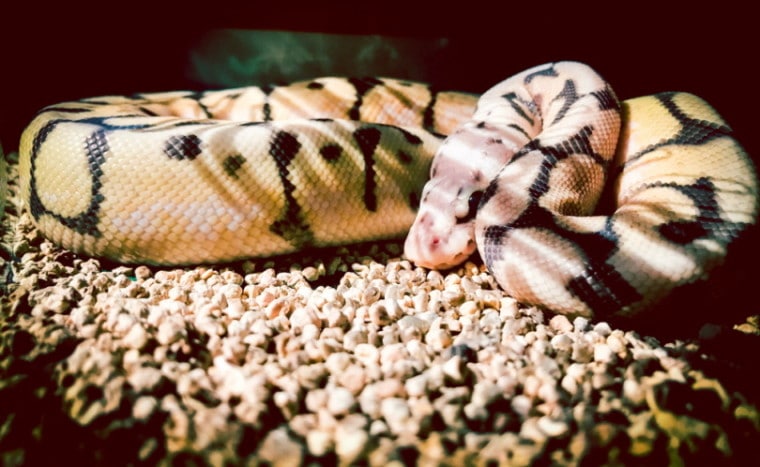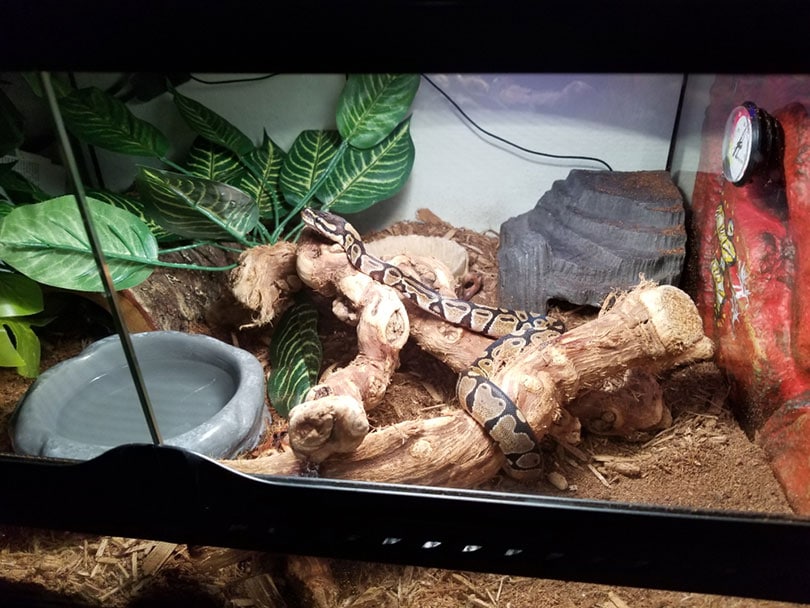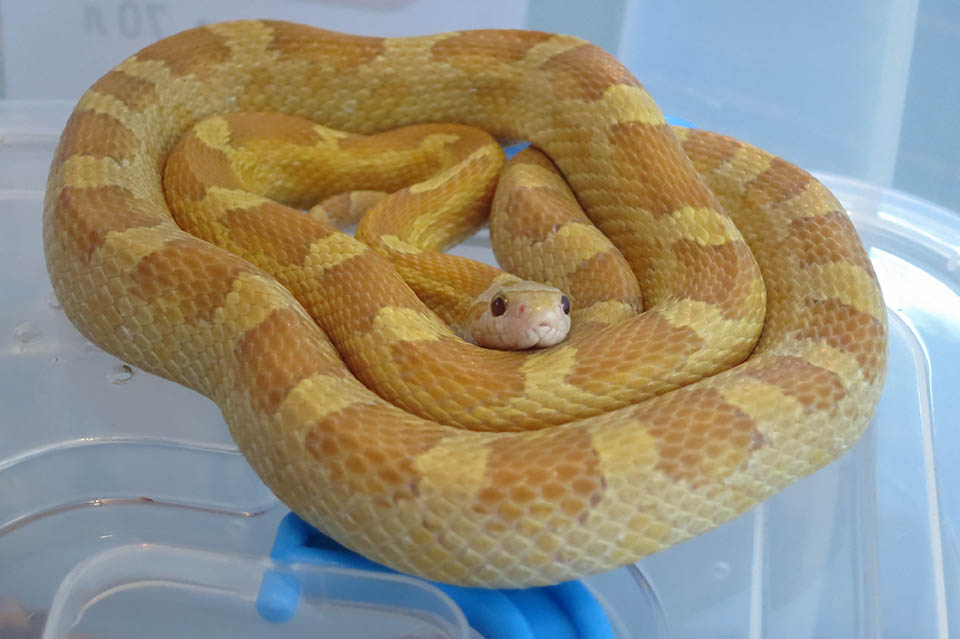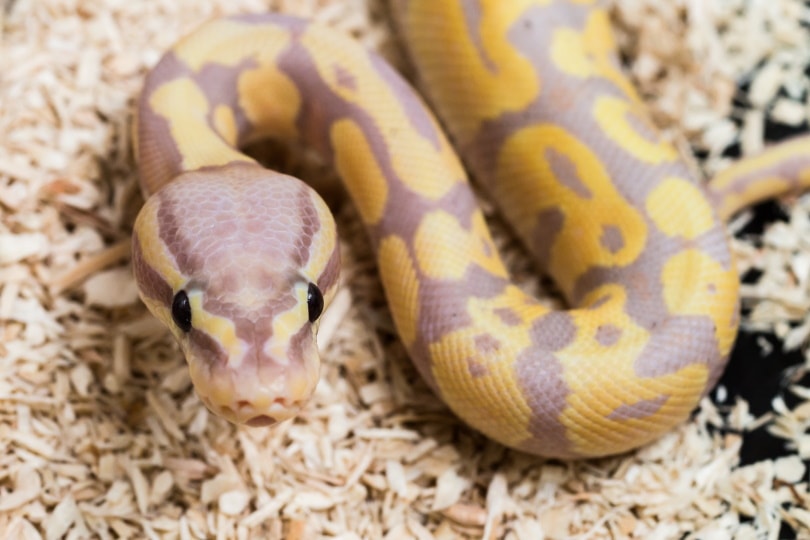
Are you looking for a slithery, scaly, pal that could make a great pet? Then look no further than the Killer Bee Ball Python! One of the most popular types of snakes available on the market, the Killer Bee Ball Python boasts a striking scale pattern, shy demeanor, and is easier to care for than other breeds of snakes.
Native to central Africa, ball pythons thrive in humid, warm enclosures and make fantastic pets for both novice and experienced snake parents. If you want to learn if this incredibly colorful snake is right for you, keep reading our in-depth Killer Bee Ball Python facts and care guide to find out more!
Quick Facts about Killer Bee Ball Pythons

| Species Name: | Python Regius |
| Common Name: | Killer Bee Ball Python |
| Care Level: | Moderate |
| Lifespan: | 30+ years |
| Adult Size: | 4 – 5 feet |
| Diet: | Rats, Mice |
| Minimum Tank Size: | 30 – 40 gallons |
| Temperature & Humidity: | 90 – 95 degrees, 50 – 60% humidity |
Do Killer Bee Ball Pythons Make Good Pets?
The Killer Bee Ball Python makes a wonderful pet for both first-time and experienced reptile owners. They are generally docile and easy to handle. However, owning any type of snake is a huge responsibility. You must be vigilant about properly maintaining its enclosure, feeding it a quality diet, and taking it in for routine wellness visits.
Appearance

Killer Bee Ball Pythons are known for their striking color combination and distinctive markings. This type of snake has gorgeous yellow scaling with purple accents. As it matures, the purple will fade to light lavender or grey. It has a unique spider web pattern over its entire body.
How to Take Care of a Killer Bee Ball Python
Habitat, Tank Conditions & Setup
The tank shouldn’t be so small as to stress or overwhelm your Killer Bee Ball Python. The tank should be at least 30 to 40 gallons. Juveniles can be kept in 20-gallon enclosures. Ensure the tank is equipped with at least two hiding places. One should be placed on the cool side of the tank and the second hiding box should be positioned on the warmer end. You’ll also need to buy a heavy water dish where your snake can also soak, thick branches, and artificial vegetation.
Tank
Spot clean the tank as necessary. Remove urine and feces daily. Use a snake-safe solution when cleaning the enclosure. Every month, thoroughly wash and clean the tank, removing all of the contents. Disinfect all reptile accessories and dishes with a five-percent bleach cleaning solution. Line the tank with newspaper, paper towels, cypress mulch, or orchid bark.
Lighting
Killer Bee Ball Pythons do best in warm, humid environments. The ambient temperature should never dip below 75 degrees. A snake lamp serves multiple purposes. It provides your pet with both heat and light. Use a basking bulb in one area of your tank where your snake can soak up the heat. Try to mimic the normal day-night cycles as closely as possible by keeping your snake’s tank dark at night. Use the 12 hours on and 12 hours off rule. Never place the enclosure directly next to a window.
Heating (Temperature & Humidity)
Maintaining proper heat and humidity levels are essential for your Killer Bee Ball Python’s wellbeing. The tank must have a constant humidity level of 50 to 60 percent. This not only allows your snake to stay comfortable, but high humidity levels also help it to molt properly. Many standard snake tanks come with heating tape already on the bottom of the enclosure. However, it’s a smart idea to place a heating mat in a particular area of the tank. Monitor the tank’s heat and humidity levels with accurate temperature and humidity gauges.
Tank Recommendations
| Tank Type: | 30+ gallon glass vivarium |
| Lighting: | Basking Bulbs |
| Heating: | Heating pad/tape on the bottom of the enclosure |
| Best Substrate: | Orchid bark, Cypress mulch |
Feeding Your Killer Bee Ball Python
Feeding a Killer Bee Ball Python is not for the faint of heart. Feed your snake an appropriately sized rodent every week. This means that the prey animal is no larger than the circumference of your snake at its largest circumference. Pythons dine on frozen or live rats and mice. Never leave a live rodent unattended with your snake as it could potentially injure your python.
During the winter, your Killer Bee Ball Python may not consume as much food as it normally would. During this time, keep an eye on your pet to monitor its weight and condition. Always ensure your Killer Bee Ball Python has access to clean, fresh water.
Diet Summary
| Fruits: | 0% of diet |
| Insects: | 0% of diet |
| Meat: | 100% of diet – small/medium-sized rodents |
| Supplements Required: | N/A |
Keeping Your Killer Bee Ball Python Healthy
It’s important to keep your Killer Bee Ball Python healthy with a high-quality diet, clean enclosure, and regular vet visits. Most health issues can be avoided with proper care. Signs of sickness include loss of appetite for long periods of time, excessive hiding, lethargy, and incomplete shedding.
Common Health Issues: mites, incomplete shedding, respiratory infections.
Lifespan
With the right care, a Killer Bee Ball Python can live 30+ years. In the wild, these snakes will only live for around 10 to 15 years.

Are Killer Bee Ball Pythons Friendly? Our Handling Advice
The Killer Bee Ball Python is a docile snake and easier to handle than other reptiles. Before picking it up, gently stroke your snake while it’s still in the enclosure. Put a hand under its mid-body and smoothly pick it up while supporting most of its body weight. Allow your Killer Bee Ball Python to coil around your arms to explore. Never hold your pet tightly. Avoid disturbing it if it’s hissing, perching upwards, or biting.
Shedding & Brumation: What to Expect
A healthy Killer Bee Ball Python will shed every four to six months. When it’s about to shed, its color will fade and its belly will look pink. Your snake’s eyes will also become dull. During the molting process, your Killer Bee Ball Python will rub back its old skin, starting at the nose. It will rub against any and all tank enclosures until the shedding process is complete. If your snake seems to be struggling, put it in a damp pillowcase or cloth bag and place the sack under a heat lamp for about two hours.
How Much Do Killer Bee Ball Pythons Cost?
A Killer Bee Ball Python will cost between $170 at the entry level, and up to $2,500 for one of the rare morphs like the Killer Bee Super Gravel morph. You can buy one online, from an exotic animal breeder, or even at a local pet store.
Care Guide Summary
Final Thoughts
If you’re looking for a great snake to purchase, consider buying a Killer Bee Ball Python. They are gorgeous, great for beginners, and easy to handle. It’s essential to provide your snake with the proper tank size and humidity levels it needs to thrive.
If you want to add an exotic reptile to your home, a Killer Bee Ball Python could be the perfect option for you!
Featured Image Credit: Bear VC, Shutterstock








